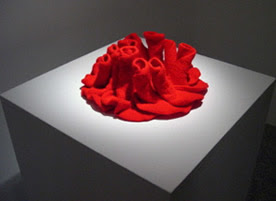Week Two: Math + Art
This week,
the content of this class focused on how math and computer science influenced
and affected art.
My favorite insight this week was how computers and math influenced music. As a bigger fan of EDM-based and DJ-oriented music, I of course knew that not all music is natural sounds and most is tampered with electronically. However, I had no idea the extent to which waveforms are entirely chopped up that completely alters the "pitch and time characteristics." (Chapter 5: The Transformation of Sound by Computer) Seeing how popular artists like Zedd, The Chainsmokers, and Jack Ü have become, computers have entirely revolutionized what is "in" musically and created a genre previously not only unperformed, but impossible.
 While of
course math and science overlap, one of the more fascinating aspects was the
fractals of African culture. It's interesting to know that even though
computers have digitized practices, general concepts of art are still
human-derived. A pattern and design layout that has been used for centuries in
textiles, architecture, and even hairstyles is just now being modeled by
science.
While of
course math and science overlap, one of the more fascinating aspects was the
fractals of African culture. It's interesting to know that even though
computers have digitized practices, general concepts of art are still
human-derived. A pattern and design layout that has been used for centuries in
textiles, architecture, and even hairstyles is just now being modeled by
science.
In a
way of combining the above, my last favorite was the connection of math
explaining art as art explains science—in a sense, the way the two are
intertwined. Daina Taimina’s crocheting of hyperbolic space was the first way
the structure was modeled physically, something scientists thought couldn’t be
done for centuries.
As
a piece to elaborate upon, I chose Jack Ü and Skrillex's mix of Justin Bieber's
vocals in "Where R Ü Now." What many don't know is the song's
flute-like background noise is actually Bieber's vocals remixed, re-pitched,
and reorganized. The song itself utilizes almost no actual instruments, and the
duo created harmonies from nearly nothing because the original song was
such a blander ballad.
I think to
call mathematics, art, and science juxtaposed at all may be incorrect. Instead,
this week has lead me to believe they are more of a three-way Venn diagram.
While in some instances, they can be seen side-by-side, it is more often a
combination of at least two, intertwined in ways that most wouldn't have
noticed. To someone who looks Daina Taimina's work and just sees twirls of
woven color, the underlying aspects of hyperbolic space are unknown and
unappreciated, but not nonexistent.
Sources:
“Chapter
5: The Transformation of Sound by Computer.” Burk, Polansky,
Repetto, Roberts, Rockmore.
http://cmc.music.columbia.edu/MusicAndComputers/chapter5/05_01.php
“Culturally
Situated Design Tools: African Fractals.” National Science
Foundation.
http://www.ccd.rpi.edu/Eglash/csdt/african/African_Fractals/homepage.html
Garibaldi,
Christina. “How Skrillex and Diplo Turned Justin Bieber’s Balled Into a Hit.” MTV News, 25 Aug. 2015.
http://www.mtv.com/news/2250577/justin-bieber-skrillex-diplo-where-are-u-now/
Medved,
Matt. “The Justin Bieber/Jack U 'New York Times' Piece Reveals Crazy 'Where Are
U Now' Fact.” Billboard,
25 Aug. 2015,
http://www.billboard.com/articles/news/dance/6677559/justin-bieber-jack-u-where-are-u-now-new-york-times.
Taimina, Daina. “Discoverer of
Hyperbolic Crochet.” Crochet Coral Reef,
April 2009,
http://crochetcoralreef.org/contributors/daina_taimina.php
Pictures:
Genius. Digital Image. “Jack Ü:
Where Are Ü Now.” Genius.
https://genius.com/Jack-u-where-are-u-now-lyrics.
https://genius.com/Jack-u-where-are-u-now-lyrics.
Programming, Math and Art. Digital
image. Computers for Creativity. http://www.computersforcreativity.com/about/programming-art-math.
Taimina,
Daina. Digital Image. “Discoverer of Hyperbolic Crochet.” Crochet Coral Reef.
http://crochetcoralreef.org/contributors/daina_taimina.php




Comments
Post a Comment